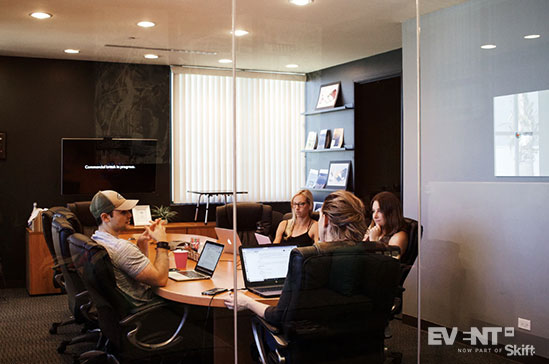This is a sponsored post from Cvent. More information about Event Manager Blog’s sponsored posts.
Internal events or meetings are organized at all companies in one form or another. These can be as small as a weekly team meeting or as big and complex as an annual field meeting. Internal events reflect a company’s culture and affect employees’ perception of their company and its leadership, which has a significant impact on retention rates, onboarding costs, and ultimately ROI.
In today’s economy, 43% of younger employees plan to leave their jobs within 2 years. This represents a huge amount of turnover that translates into increased recruiting costs for organizations. It leads to an increased risk of negative word-of-mouth from ex-employees (which has never been more damaging with review sites like Glassdoor now a common part of the job hunt), making events all the more valuable as a tool to improve employee satisfaction and loyalty.
In fact, almost 64% of survey respondents in a recent EventMB report agreed that internal events help retain employees. 92% of respondents to a Verizon survey admitted that meetings are, in fact, an excellent opportunity to contribute and a key factor in their job satisfaction. More than two-thirds of respondents to the same survey deemed internal meetings to be extremely or very productive.
With this in mind, it’s vital that organizations plan internal events strategically and understand their potential impact in order to use them to shift company culture and lead to positive outcomes for the organization.
In this post, we’ll look at three ways internal events can serve to reinforce company culture and provide some best practices for making the most of different kinds of internal events.
Current State of Internal Events
On the whole, internal meetings tend to be undervalued and underutilized. Consider that almost half of respondents to a Salary.com survey considered meetings to be the biggest waste of their time (though this is likely referring to small daily or weekly internal team meetings). Likely pertaining to larger meetings that actually require a planner, 46% of respondents in the EventMB survey reported planning five or fewer internal events annually.
Given the value of internal meetings mentioned above, there are clearly a lot of wasted opportunities when it comes to leveraging the power of these events.
Internal events are often planned by non-event employees, such as executive assistants, who don’t have the necessary expertise to plan strategic events. They often find themselves in a difficult position when tasked with executing event logistics and content. This not only applies to smaller, more manageable events but sometimes even to big-budget company-wide events. As such, internal events don’t always reach their full potential as a way to create a positive company culture.
Let’s take a closer look at three ways companies can leverage internal meetings and events to solidify company culture.
Secure Top-down Support from Leadership
Certain internal events, such as executive retreats, are inherently more exclusive and cater to the company leadership. This was one of the most common types of events organized by the EventMB survey respondents.
These events provide the opportunity for executives to regroup, brainstorm, and strategize together about the direction of the company. They may take place once a year, once a quarter, or at different intervals depending on the organization.
Culture is a key aspect of the overall company direction as it ties into the executives’ vision for the company, but retreats also give leaders an opportunity to decide how that ought to be conveyed to the rest of the employees. Although the adoption and success of the desired culture will ultimately be determined by the employees, executives play an important role in encouraging, providing top-down support, and setting the foundation for a positive work environment and culture.
4 best practices for executive retreats
Understand the meeting owner’s needs/objectives.
This goes for all types of events, but it’s something to pay particular attention to for high-level events like this. The meeting owner is likely to be the CEO, and these retreats often run the risk of leaning too heavily on leisure, so be sure you’re on the same page and are able to deliver what they’re looking for.
Make creative use of venue/event space.
Executive retreats usually take place at off-site and (likely) upscale venues and resorts that allow for more creativity than the office boardroom. Try to find ways to spice things up to encourage both productivity and relaxation in a way that wouldn’t be possible elsewhere. For example, if the setting allows for it, you can organize an informal meeting on the beach or a sunset reception on the rooftop. If a boardroom setting is absolutely necessary, prioritize natural daylight and rooms that may have a more quirky or interesting vibe.
Send relevant materials in advance when possible.
Retreats are usually only a few days long at most, so it’s important that executives make the most of their time together once onsite. If there are any materials or background information that they can look over on their own ahead of time, be sure to share this with them in advance so as not to waste time unnecessarily during the event.
Limit meeting/active brainstorming time.
While these types of events are obviously precious opportunities for leadership to meet and discuss future objectives and initiatives, it’s important to factor in a bit of R&R as well. Pay attention to event pacing and ensure that executives aren’t too burned out from meetings to be able to brainstorm and process information effectively.


Encourage Collaboration and Feedback
Although exclusive events like leadership summits help define culture and set the tone for the event program overall, larger events that involve employees are generally more culturally-defining. After all, employees are where the culture shines through on a daily basis; they’re the company’s ‘ambassadors’.
Company-wide meetings are a great way to promote company culture and include other events, such as team building events, to encourage interaction and engagement among employees. These types of larger events also allow leadership to collect feedback through surveys or other tools to see how employees view the culture and what improvements may need to be made. Incorporating interactive workshops at business events is a growing worldwide trend for good reason.
4 best practices for company-wide meetings
Make sure speakers know how to keep attendees engaged.
One of the main goals of company-wide meetings is to share information with attendees, which can be difficult to accomplish without losing attendees’ interest and wasting the valuable opportunity provided by such an event. Be sure to train speakers on how to keep presentations succinct and digestible without overwhelming the audience with text-heavy slides and tangentially related points.
Plan enough breaks.
As with leadership meetings, it’s important to avoid planning hours of information dump without providing attendees some downtime in between to absorb and process what they’re learning. Try to keep presentation segments short and plan breaks to give people the chance to reflect on the previous presentation, discuss it with their peers in an informal environment, and get ready for the next one.
Utilize interactivity tools.
Encouraging audience interaction is a great way to avoid exclusive one-way communication and keep employees engaged. This can be as simple as live polls throughout the event or post-session Q&A periods, but gamification is a great way to get people to engage with your content and reinforce other event goals, like collaboration and team bonding.
Select panelists who represent/reflect the audience.
Company-wide events include employees from different departments and who perform different functions within the organization – each with their own departmental and team dynamics and concerns. It’s important that you take this into account when determining the event breakouts and the panelists and speakers who lead them to ensure that everyone feels represented and can get the most out of the event.
Try crowdsourcing presentation and other content topic ideas using a survey before the event. You could even ask lower-level employees from different departments to prepare a presentation, giving them the opportunity to assume a bit more responsibility and address an issue that really speaks to their peers.


Bolster Employee Motivation
Using events as a method of rewarding and motivating employees is another powerful way they can define company culture. These types of events may include award ceremonies, employee recognition, or incentive trips and programs. Employees who feel valued are more likely to feel content in their job, and motivated employees who are happy to give their job their all create a positive and energetic company culture.
Event budget permitting, incentive trips in particular are an enticing reward (travel) for high-performing attendees, which also allow employees a certain degree of personal development through exposure to different cultural experiences and situations. Incorporating executives makes these events another opportunity to further solidify the corporate culture.
4 best practices for incentive events
Define your goal(s).
Although the idea of an incentive trip is to provide a fun experience for winners, it still qualifies as a business event and should therefore be planned with certain company goals in mind. These could be related to increased sales, additional training for exemplary employees, or the completion of visioning and other side-projects. Whatever the goal, it should be specific and measurable.
Clearly communicate the program and expectations to employees.
You can’t expect employees to be motivated by a reward they don’t know about. If you’ve decided to organize an incentive program within your company or within a specific department, make sure to clearly inform employees of the details as well as the expectations. They should be aware of any deadlines, performance indicators, and associated recognition or general rewards you are offering (you may say there will be a trip but not disclose the destination, for example).
Tailor the program to attendees.
The trend of personalizing events is not relegated to B2B events. Once you’ve determined who the qualifiers are, make an effort to make the program as relevant as possible to them. This also means paying attention to their specific needs and choosing locations and activities that accommodate those. Accessibility and inclusivity mean paying attention to each attendee’s place in and experience of the world, and avoiding things that alienate them. This adds to the exclusive feel of the trip and to the value of the reward you’re giving your highest-performing employees.
Tie program back to company mission/values.
The overarching goal of incentive programs is to motivate employees and promote a positive company culture where they feel valued. You should therefore always try to relate the program back to your company’s mission in some way so that the people you invite remember that they are participating in a company event and feel more inspired to go back to work after it ends. This could involve team building activities, volunteering at a charitable organization, or anything else you feel reflects and underscores your company values.


IN CONCLUSION
Internal events are a key way that companies can define and reinforce their culture, the benefits of which go beyond the three discussed here. When done right, internal events are an effective way for leadership to shape the company culture, motivate their employees, receive feedback, and increase retention. It’s important that they be given the time and attention they deserve to ensure they are organized strategically and effectively to achieve these results.
For more information on the value of internal events and how to successfully execute them, download the full report or contact Cvent for support organizing your next internal meeting.






